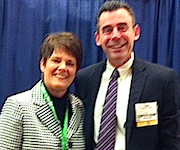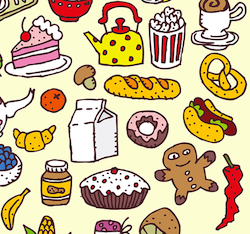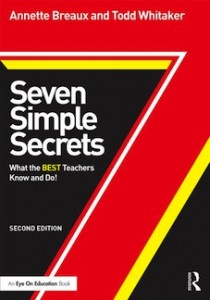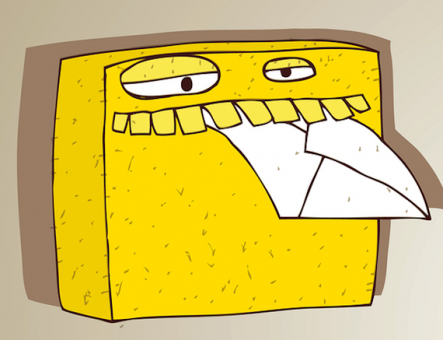How to Create an Effective Teaching Plan
Many teachers are preparing to enter their own classrooms for the first time. To help them on their way, MiddleWeb is publishing a series of brief articles offering good advice and food for thought. Here’s our final excerpt from the new edition of Seven Simple Secrets. Also check out: What an Effective Teacher’s Classroom Looks Like and How to Teach for Real Life Learning.

The most effective teachers know that if you want to have a great lesson, you need to plan a great lesson. It is truly that simple. Understand, planning takes time. But if you teach with a well-planned lesson, then you can really enjoy your teaching.
Now, does that mean that you will accomplish everything you intend to accomplish or that your plan will go off without a hitch? Of course not. Teaching is not an exact science, and that is why we need to plan so thoroughly.
The very first thing you will want to do, when you sit down to plan your lesson, is to center the entire plan around your objective—what it is you want the students to accomplish on that day. This holds true no matter what lesson plan format or template you use.
Let’s say that today you will be teaching your students how to compose a thank-you note and/or a thank-you email. This note will be for the purpose of expressing gratitude for a gift.
Determine the mode of delivery—whether it will be a hand-written note or electronic note or card. You may opt to give students a choice regarding the format. So your objective is that the students will be able to write a thank-you note, including all of the five parts—date, greeting, body, closing, and signature.
Motivation first
Now, the first thing you need to plan, of course, is how you will get your students to actually want to write a thank-you note. You might begin a discussion by asking your students if they ever receive gifts from friends or family. Discuss typical ways to express gratitude for gifts—phone calls, emails, electronic or printed thank-you cards, etc. Then discuss the thank-you note and its purpose.
Next, you may want to have a thank-you note written by you to your class, thanking them for being in your class or thanking them for something they have done that makes you grateful. This is so easy and so effective because it’s personal! Project the note onto your smart board or have it written on chart paper large enough for all to see.
Now read the note with the class, and then have them analyze each part with your guidance. As they analyze each part, have a student write the name of that part next to it. For instance, where it says, “Dear Class,” the student would label it as the “greeting.” You get the point. Bottom line? With your guidance, they will identify all of the parts of a thank-you note.
Model the skill
Now you’ll want to model the skill for them. (By the way, modeling is one of the most important steps in teaching anything to anyone, yet it is often overlooked.) To model, simply write (or type, if you are projecting from a computer or tablet) a thank-you note to a friend of yours, in a way that is large enough for all to see.
As you write, think aloud for the benefit of the students. You may even choose to allow them to guide you as you write. (Please note that you have not simply given a definition of a thank-you note and its parts. Instead, you are pulling the information from the students. This is much more meaningful, and thus lasting.)

Try out the new skill
Once you’ve actually taught and modeled the skill and then guided students through the skill, they should be ready to try the new skill on their own. So what should their assignment be? You guessed it—they will write their own thank-you notes or create their own electronic thank-you cards.

The most effective teachers know that you never tell the students what they’ve learned. Instead, you have them tell and/or show you.
There’s your plan
That’s it. You’ve written a great plan that will help you to teach an effective lesson. Yes, but what if you have one or two students who don’t spell all the words correctly in their thank-you notes? Remember, the objective was to write a thank-you note including all of its parts. No one said anything about spelling everything correctly. Focus on that objective another day.
Tips for Planning
Here are some simple tips for you to use when planning any lesson. Use them as a checklist:
▶ Determine your main objective.
▶ Decide how you will make the lesson interesting and inviting for your students.

▶ Plan to state the lesson’s purpose, relate the skill to students’ lives, teach and model the skill, practice the skill with them, have them try the new skill independently, and review.
▶ Be sure to gather any necessary materials beforehand.
▶ Enjoy teaching your well-planned lesson!
Any teacher who plans lessons with these tips in mind and gives careful thought to every step of the lesson will see instant results from students.
If you plan your lessons with careful attention and treat each one as a special invention, you’re sure to see student success and retention, reducing your levels of stress and tension!
✓ A bonus download:
Always Overplan Your Lessons – Here’s How!
_____
Editor’s note: This is the last of three excerpts that MiddleWeb is sharing from the just-published 2nd edition of the bestseller Seven Simple Secrets: What the BEST Teachers Know and Do! by Annette Breaux and Todd Whitaker. Thanks to Lauren Davis at Routledge/Eye on Education for helping us gain permission to offer these posts.
___

Todd Whitaker is a professor of educational leadership at Indiana State University and a prominent education author and speaker. Whitaker has taught at the middle and high school levels, served as a secondary school principal for eight years and as a district-level middle school coordinator. His many books include Leading School Change, What Great Principals Do Differently, What Great Teachers Do Differently and The 10-Minute Inservice. Follow him on Twitter @ToddWhitaker.

































I always asked my student teachers to write how they will evaluate a lesson’s effectiveness, based on the objective(s).
Sorry- I also ask my students to proofread…do as I say, not as I do!